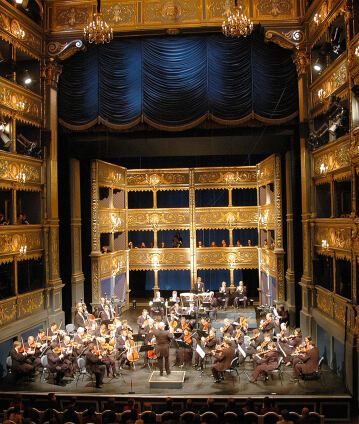Daniel Barenboim conducts Mozart at the 2006 Europakonzert from Prague

In 2006 – the 250th anniversary of Mozart’s birth – the Berliner Philharmoniker travelled to Prague to perform an all-Mozart programme at the famous Estates Theatre. Daniel Barenboim not only conducted the “Haffner” and “Linz” Symphonies but was also the soloist in the Piano Concerto No. 22. In the First Horn Concerto the brilliant soloist was Radek Baborák, the orchestra’s principal horn player.
Since 1991, the Berliner Philharmoniker have commemorated the day when they were founded in 1882 by giving a concert on 1 May in a different European venue of special cultural and historical significance. For their first such visit in 1991, they travelled to Prague to mark the bicentenary of Mozart’s death, returning there in 2006 to celebrate the 250th anniversary of his birth. It was at the famous National Theatre – renamed the Estates Theatre in 1798 – that Mozart had enjoyed some of his greatest triumphs with Le nozze di Figaro, La clemenza di Tito and especially Don Giovanni, which was specially written for the theatre.
Daniel Barenboim, who has been closely associated with the orchestra for more than fifty years, appeared in his tried and tested role as both conductor and soloist, opening the proceedings with the popular “Haffner Symphony” that Mozart wrote in the summer of 1782 based on an earlier serenade. He performed the symphony for the first time to great acclaim in Vienna in 1783. Barenboim then masterfully led the orchestra through the E flat Concerto No. 22 from the piano, just as Mozart is likely to have done: an acclaimed keyboard virtuoso, Mozart composed most of his piano concertos for his own particular use.
The first item on the programme after the interval was likewise performed without the need for outside help: the solo part in Mozart’s First Horn Concerto was taken by the young Czech horn player Radek Baborák, who was then the orchestra’s principal horn player. He was only eighteen when he won the ARD Music Competition in 1994, becoming the principal horn player with the Czech Philharmonic later that same year and joining the Berliner Philharmoniker in a similar capacity in 2003. He remained in Berlin until 2010. His performance of Mozart’s Horn Concerto was notable for what one critic called “extraordinary beauty and control”. The programme ended with the “Linz” Symphony, which Mozart wrote in only a few days in 1783. The result is a masterpiece that nowhere betrays any sign of the speed with which it was composed.
© 2006 EuroArts Music International
Categories
Artists
Our recommendations
- Daniel Barenboim and Plácido Domingo at the 1992 Europakonzert in the Escorial
- Daniel Barenboim conducts the 2014 Europakonzert in Berlin
- Daniel Barenboim conducts the 1997 Europakonzert from Versailles
- Europakonzert from Oxford with Daniel Barenboim and Alisa Weilerstein
- 2017 Europakonzert from Cyprus with Mariss Jansons and Andreas Ottensamer
- 2003 Europakonzert from Lisbon with Pierre Boulez and Maria João Pires